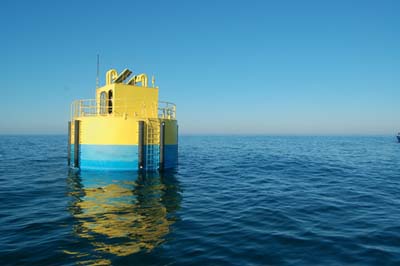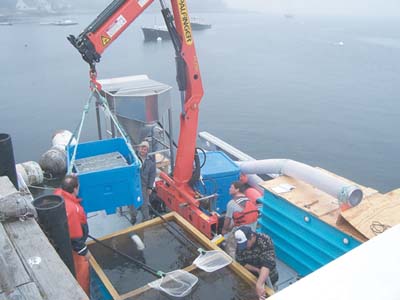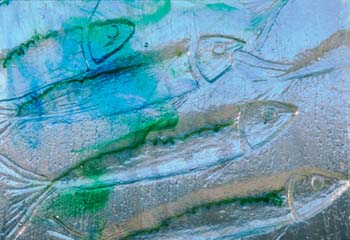 |
 |
| current issue |  | past issues |  | send a letter/news |  | address update |  | advertise |  | about us |  | alumni home |
| Spring 2009 |

|
| Departments |
 |
| Alumni News |
| Alumni Profiles |
| Book Reviews |
| Campus Currents |
| Class Notes |
| Features |
| History Page |
| Letters to the Editor |
| Obituaries |
| President's Column |
| Question/Answer |
| University Research |
 |
| Department Archives |
| Table of Contents |
|
Search UNH Magazine: |
Features
The Future of FishingPage 5 of 5
In her Rudman Hall office, Elizabeth Fairchild '91, '98G, '02G watches a video of a tiny winter flounder. "He's like a kid slurping a string of spaghetti," she says, smiling fondly as the flounder sucks up a wriggling bristle worm. Granted, even the cutest flounder has a face that only a mother could love, but in a sense this UNH research scientist qualifies. In the past 10 years, she has raised, tagged, released and monitored more than 100,000 winter flounder as part of a stock enhancement program aimed at bringing this fishery back to New England.
Once a favored catch of commercial and recreational fishermen, today flounder populations have declined so dramatically that their fate has shaped up as the latest battle between commercial fishermen and the National Marine Fisheries Service, which recently closed the winter flounder fishery south of Cape Cod.
"We're lucky in that winter flounder is an excellent candidate for stock enhancement," says Fairchild. "We know a lot about the fish itself, we have great support from fishermen who bring us wild broodstock, and we know how to raise them."
 |

|
| FARM FRESH: UNH researchers designed a 20-ton payload feeder, left, to ride 30-foot waves and to be operated remotely. Taking healthy fish to market, right, requires daily feeding. | |
It sounds simple enough. Raise batches of fish, let them go and let nature take its course. But that, according to Fairchild, would be a good way to run a feeding program for green crabs.
"Fish raised in the hatchery haven't learned to fend for themselves," she says. So Fairchild and her team run a survival training camp for baby flounder. The researchers line the bottom of the tanks with sediment so the flounder can practice burrowing and camouflaging themselves. Since catching and eating live prey like bristle worms is challenging—for anyone—the researchers encourage the tiny fish to practice in the hatchery.
Hatchery-raised flounder also need help coping with the crab-eat-fish food chain. Initially the researchers used acclimation cages that would sit on the bottom of an estuary to give the flounder time to adjust. Green crabs, however, would wait patiently outside for the release day; then they'd move in for a feast.
"We tried moving these cages around, but that stressed the flounder out," Fairchild says. "Then we raised the cages off the bottom. That seemed to help, but flounder tend to stick around the cage after release, which makes them vulnerable. We've made some progress, but that's a nut we still have to crack."
Fairchild's work has begun to attract the attention of fishermen, and she recently has begun to talk to New York fishermen about a winter flounder stock enhancement program in their area. Ultimately, she sees efforts like this as the embodiment of the local foods movement. "Winter flounder is a local native food," says Fairchild, "and stock enhancement can create local jobs. For it to succeed, it needs to be a community-based effort."
Andrew Rosenberg likes to tell a joke about fisheries management. "Counting fish is just like counting trees," he says, "except the trees don't move and you can see them." Rosenberg heard it from the late Ransom Myers, a mentor and colleague. As a joke, it still has legs, perhaps because it neatly sums up the challenge of managing a natural resource as elusive as fish.
"While a lot of people will debate whether the state of the world's fisheries is terrible or merely bad," says Rosenberg, "just about everyone acknowledges that they are in trouble." To reverse that trend, he says, fisheries management will have to catch up with the capacity of a technology that allows us "to fish anywhere on Earth for any stock we want and then sell that product to any market that will buy it."

It's daunting when you consider the factory-style bottom trawlers that operate illegally on the high seas, dragging nets the length of a football field and hauling up many metric tons of fish and any other marine animal they can scrape up off the ocean bottom. These vessels are equipped to sort, process, and freeze the fish right on board. It would appear the fish, and the regulators, do not stand a chance.
Yet the outlook is not completely gloomy. There are success stories, like the scallop in New England, which has bounced back from the brink of commercial extinction. Rebuilding the stocks is possible, Rosenberg says, if we can think differently.
"Right now we reduce days at sea, limit catch quotas and restrict the kind of gear that fishermen are allowed to use," says Rosenberg. The best approach is to adopt several strategies that complement each other, he believes.
There will never be a silver bullet when it comes to managing the fisheries, says Rosenberg. Instead of managing an already complicated set of activities like fishing and coastal development separately, he advocates for an integrated approach in the much larger picture of ecosystem-based management. In this light, a future that includes thriving oceans that are teeming with fish depends on decisions we make on land—together. ~
Dolores Jalbert Leonard is the communications manager for the UNH/NOAA Cooperative Institute for Coastal and Estuarine Environmental Technology.
Easy to print version
Return to Sticker Shock feature story blog comments powered by Disqus